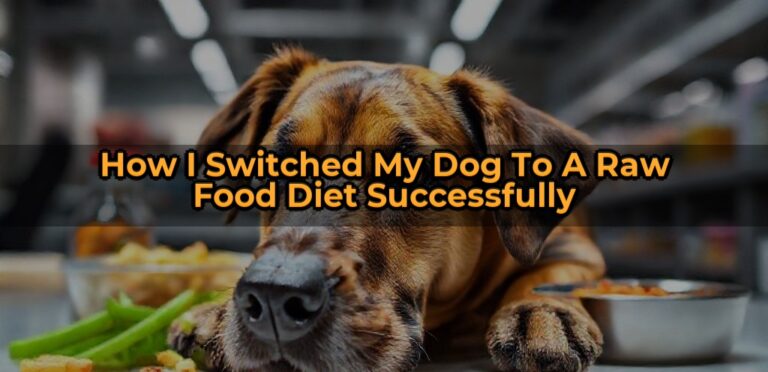How to Transition Your Pet to a Healthier Diet Safely
It wasn’t long ago that I watched my dog, Max, struggle with allergies and sluggish energy. Despite switching food brands twice, nothing seemed to help. Then I started digging into how diets impact pets’ health. That’s when I realized something—it’s not just about changing food; it’s about doing it right. A sudden switch can upset their stomach, cause behavioral issues, or worse, trigger allergic reactions. I found out that transitioning pets to a healthier diet isn’t a matter of simply swapping bowls. It’s a strategic process backed by common sense, veterinary advice, and good old patience.
Understanding Why Transitioning Matters
Digestive Sensitivity and Microbiome Disruption
Pets, especially dogs and cats, have delicate digestive systems. Shifting their diet abruptly can throw their gut bacteria into chaos. I saw this firsthand with Max—vomiting, diarrhea, refusal to eat, the whole nine yards.
Why does that happen? Think of the pet’s gut as a finely balanced ecosystem. Switch foods suddenly, and it’s like dumping a new species into their habitat—mayhem ensues. The microbiome needs time to adapt, which means gradually introducing new foods is key.
Behavioral and Nutritional Stability
Sudden diet changes can cause confusion and stress. Imagine suddenly stopping your favorite meal—painful, right? Pets are no different. A gradual approach helps keep their behavioral calm, avoids stress-induced issues, and ensures they’re actually consuming the nutrients they need for health, not just packages labeled “healthy.”
Establishing a Clear Transition Strategy
Why a Slow Shift Wins
Based on my experience, a slow transition over 7-14 days is the sweet spot. Shorter than that, and I’ve seen pets refuse food or get gastrointestinal upset. Longer than two weeks, and the process loses momentum and patience frays.
The goal is to give their digestive system time to recalibrate, so they’re not switching from one extreme to another but instead easing into their new diet.
Step-by-Step Transition Framework
- Days 1–3: Mix 25% new food with 75% old food
- Days 4–6: Increase to 50% new food, 50% old food
- Days 7–9: Progress to 75% new, 25% old
- Days 10–14: Transition to 100% new food

frays.The goal is to give their digestive system time to recalibrate, so they’…
This ratio isn’t set in stone. If your pet shows signs of distress—vomiting, diarrhea, refusal to eat—pause and revert to a lower percentage of new food until symptoms subside. Patience and attentiveness are your best friends here.
Choosing the Right Food for Transition
Nutritional Profile Over Brand Names
For a truly good transition, it’s about matching nutritional profiles—not just chasing trendy ingredients or clear labels. I’ve seen pet owners fall for marketing hype, ending up with a diet that’s not inherently better for their furry friend. Focus on the basics: high-quality protein, appropriate fat levels, fiber, omega fatty acids, vitamins, and minerals.
Switching to a new brand that claims “grain-free,” “protein-rich,” or “superfood-packed” requires scrutiny. Read the label—look for recognizable ingredients and avoid fillers, artificial additives, or excessive carbs.
Identifying Suitable Options
- Match calorie content with what your pet currently consumes to avoid overfeeding or underfeeding.
- Check for certifications—AAFCO approval, veterinary formulations, or third-party testing.
- Choose foods that align with your pet’s age, size, and health status. For example, low-fat for less active pets, higher protein for active ones.
My tip: consult with a vet before switching to ensure the new food suits their unique needs.
Monitoring Your Pet During Transition
Behavioral and Physical Signs to Watch For
During the switch, keep tabs on how your pet responds. Notice if they’re refusing food, vomiting, experiencing diarrhea, or showing signs of discomfort. I learned to keep a log—note the date, the food ratio, and any symptoms.
Small changes are expected, but persistent issues demand intervention. If Max started vomiting after Day 4, I slowed the process, reverting to a lower percentage of new food until he recovered.
Adjusting the Plan as Needed
- If symptoms are mild, proceed gradually.
- For severe reactions—persistent vomiting, lethargy, refusal—consult an emergency vet and pause the transition.
- Sometimes, the particular ingredient or formula might not suit your pet’s unique digestive makeup. Don’t hesitate to try a different brand or formulation.
The Role of Supplements and Additional Tips
Can Supplements Help?
In my experience, adding probiotic powders or fermented treats can assist in stabilizing gut flora. However, don’t rely solely on supplements; improve the diet first. Think of supplements as support rather than a fix-all.
Additional Tips for a Smooth Transition
- Feed at regular times to establish routine.
- Maintain hydration with fresh water available at all times.
- Introduce new foods in small amounts—avoid large portions initially.
- Mix textures—if switching from kibble to raw, for example, start with moist or semi-soft options.

After section: The Role of Supplements and Additional Tips
Real-World Mistakes to Avoid
I’ve witnessed owners rushing the process, swapping foods overnight or forcing their pets into eating new diets without gradual steps. That’s a guaranteed recipe for upset stomachs and mistrust. Remember, patience isn’t just a virtue; it’s the foundation of a successful diet change.
Another mistake? Ignoring signs of distress. If your pet shows adverse reactions, pause and re-evaluate. Sometimes, trial-and-error reveals their individual intolerance or preference.
Building Confidence in the Process
Over the years, I’ve found that consistency and attention to detail are key. Each pet is different—what worked wonders for Max might need tweaking with your cat or smaller dog. Trust those signs they give you; they’re more intelligent than we often realize.
Just remember: a slow, systematic approach reduces stress, minimizes health risks, and makes the new diet a positive change rather than a traumatic one. Next, I’ll cover how to fine-tune the process based on your pet’s specific condition and some advanced tips for those with special needs, so stay tuned.
Monitoring Progress and Adjusting Along the Way
As you settle into your new feeding routine, keep a close eye on your pet’s behavior and health. This isn’t just about whether they’re eating their food; it’s about their overall well-being. Look for changes in stool consistency, energy levels, coat condition, and even mood. If you notice any persistent signs of discomfort—vomiting, diarrhea, lethargy—it’s time to reassess.
One of the biggest mistakes pet owners make is pushing a new diet too aggressively. When something isn’t quite right, the temptation may be to double down, thinking they’ll “push through” the discomfort. But that often worsens the issue—sometimes leading to dehydration or even nutrient deficiencies. Instead, approach adjustments with patience.
For instance, if your pet exhibits diarrhea beyond the first few days, consider decreasing the new food proportion and easing into it even more gradually. Sometimes, a simple tweak—like adding boiled rice or pumpkin to their meals—can help stabilize digestion while your pet acclimates. Keep a journal or use an app to track these changes; it’s surprising how small patterns can provide powerful insights over time.
Case study time: I worked with a dog named Benny who developed intermittent loose stools during his transition. Turns out, his gut needed a longer adjustment period. I recommended scaling back the new diet to 10% and doubling the increase every week—essentially pausing and then slowly progressing. Within a couple of weeks, Benny’s digestion normalized. That kind of patience and careful adjustment makes all the difference.
Recognizing When to Consult Professionals
Sometimes, despite your best efforts, things don’t go as planned. Your pet’s reaction to a new diet can reveal underlying health issues or food sensitivities you might not be aware of. If your pet shows sustained vomiting, abdominal pain, or refuses to eat altogether, don’t hesitate to seek veterinary advice. Your vet can perform diagnostics that uncover hidden conditions like allergies, inflammatory bowel disease, or metabolic issues.
In some cases, your veterinarian might recommend specific testing—elimination diets, blood panels, or stool analysis—to pinpoint the problem. This isn’t about second-guessing your judgment but recognizing when specialized guidance can prevent long-term health complications. Remember, no one knows your pet better than you, but professionals bring an essential perspective and diagnostic tools to the table.
Pro tip: When visiting the vet, bring detailed notes on what you’ve tried, how your pet has responded, and any changes you’ve observed. Sometimes, small details—like subtle paw licking or changes in sleep patterns—offer crucial clues.
Fine-Tuning the Diet for Long-Term Success
Once your pet is stable on the new diet, focus shifts to maintaining that improvement. Variations in ingredients, feeding schedules, and portion sizes can influence long-term health. Keep in mind, a diet isn’t static; it should evolve based on your pet’s age, activity level, and health status.
One pro tip: diversify protein sources, but do so gradually. Switching from chicken to fish or beef can provide a broader nutrient profile and prevent food aversion. Add tiny amounts first, observe, and build up slowly, ensuring your pet’s system adapts smoothly.
For example, I have a cat that loves salmon but shows signs of skin irritation when I introduce it too quickly. By starting with a small amount mixed into her usual food and increasing slowly, I turned a potential allergy into a positive addition. Remember, diversity isn’t just exciting for them but also beneficial for gut microbiota and nutrient intake.
Incorporating Supplements Wisely

junk food in human diets. More isn’t always better. A targeted approach works…
Sometimes, a well-balanced diet still needs a boost. Supplements like omega-3 fatty acids, probiotics, or joint-support formulas can enhance overall health, especially if your pet has special needs. But before adding anything, consult your vet.
One mistake is over-supplementing—think of it like junk food in human diets. More isn’t always better. A targeted approach works best, especially if backed by diagnostics or professional guidance. For instance, adding omega-3s can improve coat shine and reduce inflammation, but only if the baseline diet is already balanced.
Adapting the Environment to Support New Dietary Changes
Food isn’t the only factor in successful dietary transitions. Make their eating environment as stress-free as possible. Consistent feeding spots, calm surroundings, and avoiding disruptions during mealtime can help prevent digestive issues and encourage positive associations with new food.
If your pet is particularly anxious or sensitive, try feeding in a quiet, familiar space. Incorporate puzzle feeders or interactive bowls to make mealtime engaging. It’s not just about nutrition but also about making them comfortable and eager to eat.
Understanding the Science Behind Your Choices
Choosing a healthy diet means understanding the nutritional science. Ideally, aim for foods that match your pet’s life stage, breed, and health profile. Read labels carefully—look out for clearly identified protein sources, limited fillers, and appropriate nutrient levels.
Some pet owners lean toward homemade diets, which can be a fantastic way to control ingredients, but it requires careful planning. Consulting a pet nutritionist often pays off here, ensuring the homemade formulas meet all their dietary needs without unintended deficiencies.
Trust me, having a solid grasp on macro and micronutrient needs allows you to create more personalized, effective diets for your pets. It’s like tailoring a suit—fit and function matter tremendously.
Final Thoughts
Transitioning your pet to a healthier diet is a journey that demands patience, attentive monitoring, and flexibility. It involves understanding their unique needs and responding adaptively. Don’t rush the process; aggressive changes often backfire, creating stress and setbacks. Instead, embrace a steady, incremental approach—celebrating small victories along the way.
Imagine your pet enjoying their meals, thriving with a vibrant coat, and showing renewed energy. That’s the reward of a thoughtful, carefully managed diet change. It’s about nurturing long-term health, not quick fixes or shortcuts.
Stay curious, stay informed. Your veterinarian is an invaluable partner in this process, guiding you with insights tailored specifically to your pet’s health. Consider scheduling a check-up to discuss your dietary plan once your pet stabilizes. Together, you can fine-tune their nutrition plan for optimal vitality.
Every pet deserves a diet designed for their individual needs, and your commitment to that process makes a real difference. Keep observing, learning, and adapting. Your pet’s health is a lifelong journey, and healthful eating sets a strong foundation. Ready to take the next step? Explore new recipes, experiment with ingredients—your pet will thank you for the effort you put into their well-being.
— — AI





